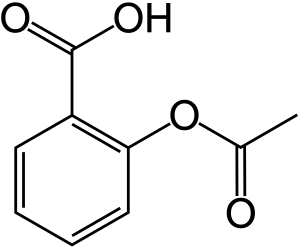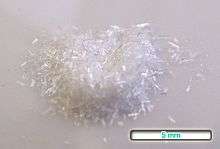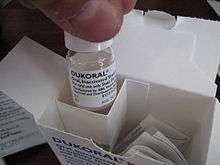WHO Model List of Essential Medicines for Children
The WHO Model List of Essential Medicines for Children is a list, proposed by the World Health Organization (WHO), of the most effective and safe medicines for use in children up to 12 years of age needed to meet the most important needs in a basic health-care system.[1] The list is divided into core items and complementary items. The core items are deemed to be the most cost effective options for key health problems and are usable with little additional health care resources. The complementary items frequently require additional infrastructure such as specially trained health care providers or diagnostic equipment. The first list for children was created in 2007, and the list is in its 7th edition as of 2019.[2]
Note: In the following article, an α indicates the medicine is a complementary item, for which specialised diagnostic or monitoring and/or specialist training are needed. An item may also be listed as complementary on the basis of higher costs and/or a less attractive cost/benefit ratio.
Anaesthetics
General anaesthetics and oxygen
Inhalational medicines
Local anaesthetics
Medicines for pain and palliative care
Non-opioids and non-steroidal anti-inflammatory drugs (NSAIDs)

- Acetylsalicylic acid (aspirin)
- Ibuprofen
- Paracetamol[note 2] (acetaminophen)
Medicines for other common symptoms in palliative care
Antiallergics and medicines used in anaphylaxis
- Dexamethasone
- Epinephrine (adrenaline)
- Hydrocortisone
- Loratadine[note 4]
- Prednisolone
Antidotes and other substances used in poisonings
Non-specific
Specific
Anticonvulsants/antiepileptics
- Carbamazepine
- Diazepam
- Lorazepam
- Phenobarbital
- Phenytoin
- Valproic acid (sodium valproate)
- Ethosuximideα
Anti-infective medicines
Antihelminthics
Intestinal antihelminthics

Antifilarials
Antischistosomals and other antinematode medicines
Antibiotics
Beta lactam medicines
- Amoxicillin
- Amoxicillin/clavulanic acid (amoxicillin + clavulanic acid)
- Ampicillin
- Benzathine benzylpenicillin
- Benzylpenicillin
- Cefalexin
- Cefazolin[note 5]
- Ceftriaxone[note 6]
- Cloxacillin
- Phenoxymethylpenicillin (penicillin V)
- Procaine benzylpenicillin[note 7]
- Cefotaximeα[note 8]
- Ceftazidimeα
- Imipenem/cilastatinα[note 9]
Other antibacterials
Antileprosy medicines
Antituberculosis medicines

Antifungal medicines
Antiviral medicines
Antiherpes medicines
Antiretrovirals
Nucleoside/nucleotide reverse transcriptase inhibitors
- Abacavir (ABC)
- Lamivudine (3TC)
- Stavudine (d4T)
- Zidovudine (ZDV or AZT)
Non-nucleoside reverse transcriptase inhibitors
- Efavirenz (EGV or EFZ)
- Nevirapine (NVP)
Protease inhibitors
200mg.jpg)
Fixed-dose combinations
Other antivirals
Antihepatitis medicines
Medicines for hepatitis C
No listings in this section.
Antiprotozoal medicines
Antiamoebic and antigiardiasis medicines
Antileishmaniasis medicines
Antimalarial medicines
For curative treatment
For prophylaxis
Antipneumocystosis and antitoxoplasmosis medicines
Antitrypanosomal medicines
African trypanosomiasis
1st stage
American trypanosomiasis
Antineoplastic and immunosuppressives
Immunosuppressive medicines
Cytotoxic and adjuvant medicines
Hormones and antihormones
Antiparkinsonism
No listings in this section.
Medicines affecting the blood
Antianaemia medicines
Medicines affecting coagulation
Other medicines for haemoglobinopathies
Blood products and plasma substitutes of human origin
Blood and blood components
Plasma-derived medicines
Human immunoglobulins
Blood coagulation factors
Plasma substitutes
Cardiovascular medicines
Antianginal medicines
No listings in this section.
Antiarrhythmic medicines
No listings in this section.
Antihypertensive medicines
Medicines used in heart failure
Antithrombotic medicines
No listings in this section.
Lipid-lowering agents
No listings in this section.
Dermatological (topical)
Antifungal medicines
Anti-infective medicines
Anti-inflammatory and antipruritic medicines
Medicines affecting skin differentiation and proliferation
Scabicides and pediculicides
Disinfectants and antiseptics
Antiseptics
Disinfectants
Gastrointestinal medicines
Antiulcer medicines
Antiemetic medicines
Anti-inflammatory medicines
No listings in this section.
Laxatives
No listings in this section.
Medicines used in diarrhoea
Oral rehydration
Medicines for diarrhoea
Hormones, other endocrine medicines, and contraceptives
Adrenal hormones and synthetic substitutes
Androgens
No listings in this section.
Contraceptives
No listings in this section.
Oestrogens
No listings in this section.
Insulins and other medicines used for diabetes
Ovulation inducers
No listings in this section.
Progestogens
No listings in this section.
Thyroid hormones and antithyroid medicines
Immunologicals
Diagnostic agents
- Tuberculin, purified protein derivative (PPD)
Sera and immunoglobulins
Vaccines

- BCG vaccine
- Cholera vaccine[note 39]
- Diphtheria vaccine
- Haemophilus influenzae type b vaccine
- Hepatitis A vaccine[note 39]
- Hepatitis B vaccine
- HPV vaccine
- Influenza vaccine[note 40]
- Japanese encephalitis vaccine[note 41]
- Measles vaccine
- Meningococcal meningitis vaccine[note 39]
- Mumps vaccine[note 40]
- Pertussis vaccine
- Pneumococcal vaccine
- Poliomyelitis vaccine
- Rabies vaccine[note 39]
- Rotavirus vaccine
- Rubella vaccine
- Tetanus vaccine
- Tick-borne encephalitis vaccine[note 41]
- Typhoid vaccine[note 39]
- Varicella vaccine[note 40]
- Yellow fever vaccine[note 41]
Muscle relaxants (peripherally-acting) and cholinesterase inhibitors
Eye preparations
Anti-infective agents
Anti-inflammatory agents
Local anaesthetics
Miotics and antiglaucoma medicines
No listings in this section.
Mydriatics
- Atropine[note 42]
- Epinephrine (adrenaline)α
Oxytocics and antioxytocics
No listings in this section.
Peritoneal dialysis solution
- Intraperitoneal dialysis solution (of appropriate composition)α
Medicines for mental and behavioural disorders
Medicines used in psychotic disorders
Medicines used in mood disorders
Medicines used in depressive disorders
Medicines used in bipolar disorders
No listings in this section.
Medicines for anxiety disorders
No listings in this section.
Medicines used for obsessive compulsive disorders
No listings in this section.
Medicines for disorders due to psychoactive substance use
No listings in this section.
Medicines acting on the respiratory tract
Antiasthmatic medicines
- Budesonide
- Epinephrine (adrenaline)
- Salbutamol (albuterol)
Solutions correcting water, electrolyte and acid-base disturbances
Parenteral
Miscellaneous
Vitamins and minerals
Ear, nose and throat medicines in children
Specific medicines for neonatal care
Medicines administered to the neonate
- Caffeine citrate
- Chlorhexidine
- Ibuprofenα
- Prostaglandin Eα
- Surfactantα
Medicines for diseases of joints
Medicines used to treat gout
No listings in this section.
Disease-modifying agents used in rheumatoid disorders
Notes
- Thiopental may be used as an alternative depending on local availability and cost.
- Not recommended for anti‐inflammatory use due to lack of proven benefit to that effect
- Alternatives limited to hydromorphone and oxycodone.
- There may be a role for sedating antihistamines for limited indications (EMLc)
- For surgical prophylaxis.
- Do not administer with calcium and avoid in infants with hyperbilirubinaemia
- Procaine benzylpenicillin is not recommended as first-line treatment for neonatal sepsis except in settings with high neonatal mortality, when given by trained health workers in cases where hospital care is not achievable.
- 3rd generation cephalosporin of choice for use in hospitalised neonates.
- Only listed for the treatment of life‐threatening hospital‐based infection due to suspected or proven multidrug‐resistant infection
- Only listed for single‐dose treatment of genital Chlamydia trachomatis and of trachoma.
- For use only in patients with HIV receiving protease inhibitors.
- For treatment of latent TB infection (LTBI) only
- Terizidone may be an alternative.
- Prothionamide may be an alternative.
- Ofloxacin and moxifloxacin may be alternatives based on availability and programme considerations.
- Potentially severe or complicated illness due to confirmed or suspected influenza virus infection in accordance with WHO treatment guidelines.
- For the treatment of viral haemorrhagic fevers.
- To be used in combination with artesunate 50 mg.
- For use in the management of severe malaria.
- Not recommended in the first trimester of pregnancy or in children below 5 kg.
- To be used in combination with either amodiaquine, mefloquine or sulfadoxine + pyrimethamine.
- Other combinations that deliver the target doses required such as 153 mg or 200 mg (as hydrochloride) with 50 mg artesunate can be alternatives.
- For use only for the treatment of P.vivax infection.
- For use only in combination with quinine.
- To be used in combination with artesunate 50 mg.
- Only for use to achieve radical cure of P.vivax and P.ovale infections, given for 14 days.
- For use only in the management of severe malaria, and should be used in combination with doxycycline.
- Only in combination with artesunate 50 mg.
- For use only in central American regions, for use for P.vivax.
- For use only in combination with chloroquine.
- To be used for the treatment of Trypanosoma brucei gambiense infection.
- To be used for the treatment of the initial phase of Trypanosoma brucei rhodesiense infection.
- To be used for the treatment of Trypanosoma brucei gambiense infection
- Only to be used in combination with eflornithine, for the treatment of T. b. gambiense infection.
- Deferasirox oral form may be an alternative, depending on cost and availability.
- Polygeline, injectable solution, 3.5% is considered as equivalent.
- In acute diarrhoea zinc sulfate should be used as an adjunct to oral rehydration salts
- Exact type to be defined locally.
- Recommended for some high-risk populations
- Recommended for immunisation programmes with certain characteristics
- Recommended for certain regions
- Or homatropine (hydrobromide) or cyclopentolate (hydrochloride).
- Ergocalciferol can be used as an alternative.
- For use for rheumatic fever, juvenile arthritis, Kawasaki disease
References
- "Essential medicines". World Health Organization. Retrieved 20 January 2017.
- "World Health Organization model list of essential medicines for children: 7th list 2019". 2019. hdl:10665/325772. Cite journal requires
|journal=(help)